Betting Scenario for the Management of University Professional Practices from the Conformation of Intersectoral Cooperation Networks
Abstract
1. Introduction
2. Background of the Study
3. Research Context
4. Materials and Methods
5. Results
5.1. Structural Analysis
5.2. Analysis of the Variables According to Their Motor Skills and Dependency
5.3. Identification of Key Variables
- Input variables, determinants, brake or motors (above, on the left): they are highly motor, little dependent and determine the operation and evolution of the system. Within this group are legal aspects related to professional practices. Any modification in them will have repercussions throughout the system and determine its operation; depending on its evolution, they can become inhibitors or promoters of it. In the area of planning, for the decision makers, it is hoped that they stimulate the appropriate behaviors to follow for the improvement of the system under study.
- Repetitive variables (top right) subdivided into: key and objective variables. The keys are located in the upper right part, they are highly motor and dependent, they affect the normal functioning of the system, which makes them variables of great importance and members of the strategic axis; in this group we can mention: shared objectives, reticular culture, information flow, managerial support, execution of the university–government–company relationship, infrastructure and equipment for networking, among others. These variables have the capacity to disturb the normal functioning of the system. Any modification to them will have an effect on themselves and on the output variables.
- 3.
- Squad or first-order regulatory variables: located in the central part of the plane, they participate in the functioning of the system under normal conditions. They become “passing mechanisms” to achieve compliance with the key variables and make them evolve in a convenient way to achieve the objectives. They require good operation, so as not to cause a break in the studied system. Among them are legal aspects related to professional practices and didactic guidance for the execution of practices. To the extent that the legal aspects are flexible and there are didactic guidelines for the development of professional practices, the process will be effective in the actors involved. Given the variables identified here, it is necessary to monitor them periodically to avoid system breakdown.
- 4.
- Excluded or autonomous variables (below, on the left): they are low motor and dependent, so they are located in the area close to the origin. They correspond to past trends or inertia of the system, or they are disconnected from it. They do not constitute a determining part for the operation of the system. In this group, for the system under study, only geographic proximity is found. However, the geographical situation of the actors involved in the network must be taken into consideration, since at the historical moment when network design is proposed, it has great value, because in situations where a frontal relationship is warranted it could be hindered; likewise, the experts opted for the use and management of information and communication technologies to be in contact, without considering geographical proximity as something that interferes in the relationship.
- 5.
- Output variables (below, on the right): they account for the results of the operation of the system, they are little motor and highly dependent, they are classified as sensitive variables, often being translated as the objectives to be achieved, for which requires follow-up to control their performance and effectiveness on the studied system.
5.4. The Strategy Axis
5.5. Analysis of the Studied System Based on the Interpretation of the Arrangement of the Variables in the Axis of the Strategy
5.6. Construction of Scenarios That Enable the Operation of the CUGE Network SMIC
- The probability of occurrence of each event was determined individually, which for the case under study is a horizon of 10 years (simple probability).
- The probability of occurrence of an event was calculated if another occurs, P(i/j), that is, the probability P, that i occurs, if J occurs (conditional probability)
- The probability of occurrence of an event was obtained, if another P(i/~j) does not occur, that is, the probability P, that i occurs, if j does not occur (conditional probability).
5.7. Results Obtained from the Application of the SMIC Survey
6. Discussion and Conclusions
Author Contributions
Funding
Institutional Review Board Statement
Informed Consent Statement
Data Availability Statement
Conflicts of Interest
References
- Bradfield, R.; Wright, G.; Burt, G.; Cairns, G.; Van Der Heijden, K. The origins and evolution of scenario techniques in long range business planning. Futures 2005, 37, 795–812. [Google Scholar] [CrossRef]
- Romero-Borre, J.; Hernández-Fernández, L.; Portillo-Medina, R.; Hernández-Chacín, A. Internacionalización de la empresa familiar: Un modelo prospectivo. Inf. Tecnol. 2022, 33, 131–144. [Google Scholar] [CrossRef]
- Millán, E.; Torrealba, A.; Ortiz, M. Formulación de Indicadores de Gestión como herramienta de desarrollo empresarial para la empresa de transporte, Inversiones Los Chabalos, C.A. Espacios 2015, 36, 21. [Google Scholar]
- Rodríguez, J. Diseño prospectivo de escenarios para la ciencia, tecnología e innovación al 2040. Ind. Data 2016, 16, 92–105. [Google Scholar] [CrossRef]
- Armijos, L.; Gómez, J. La prospectiva estratégica como herramienta de planificación en instituciones de educación superior de Latinoamérica. Qualitas 2017, 14, 102–124. [Google Scholar]
- Díaz, M.; Rosero, J.; Prías, O.R. Métodos Prospectivos Implementados en la Vigilancia Tecnológica y Prospectiva de Vehículos Eléctricos (EV) y Tecnologías Periféricas en Colombia. INGE CUC 2015, 11, 59–67. [Google Scholar] [CrossRef]
- Godet, M. Caja de Herramientas de la Prospectiva Estratégica. 2000. Available online: http://es.laprospective.fr/dyn/espagnol/bo-lips-esp.pdf (accessed on 15 January 2023).
- Alfonso, C.G.; González, M.D.L.O.B.; Cumplido, F.J.S. Cooperativismo, factor empresarial y desarrollo económico: Un modelo teórico de enlace. Revesco 2016, 122, 110–134. [Google Scholar] [CrossRef]
- Marín-González, F.; Senior-Naveda, A.; Castro, M.N.; González, A.I. Knowledge Network for Sustainable Local Development. Sustainability 2021, 13, 1124. [Google Scholar] [CrossRef]
- Galvão, A.R.; Mascarenhas, C.; Marques, C.S.; Braga, V.; Moreira, L.; Ferreira, P.; Castro, T. Sustainable International Expansion via Cooperation Networks in the Manufacturing Industries. Sustainability 2021, 13, 14013. [Google Scholar] [CrossRef]
- González-Geraldo, J.L. La transferencia de conocimiento en educación. Un desafío estratégico. Rev. Complut. Educ. 2021, 32, 153–154. [Google Scholar] [CrossRef]
- Gao, J.; Yu, X. Factors Affecting the Evolution of Technical Cooperation among “Belt and Road Initiative” Countries Based on TERGMs and ERGMs. Sustainability 2022, 14, 1760. [Google Scholar] [CrossRef]
- Espinoza, R.; Marín, F. Redes de investigación transdisciplinar tecnocientífico en contextos reticulares. Utop. Prax. Latinoam. 2019, 24, 173–193. [Google Scholar]
- Espinal, D.; Scarpetta, G.; Cruz, N. Análisis prospectivo estratégico de la educación superior en Colombia. Cult. Educ. Soc. 2020, 11, 177–196. [Google Scholar] [CrossRef]
- De Rolt, C.R.; Dias, J.D.S.; Peña, F.T.G. Network Analysis as a Management Tool for Inter-organizational Projects. Gest. Prod. 2017, 24, 266–278. [Google Scholar] [CrossRef]
- Arbeiter, J.; Bučar, M. Cross-Sectoral Cooperation; Bridge: Los Angeles, CA, USA, 2021; Volume 47, Available online: https://www.tepsa.eu/cross-sectoral-cooperation-for-sustainable-futures-jana-arbeiter-and-maja-bucar-cir-slovenia/ (accessed on 15 January 2023).
- Berndt, D. Strategies for Professional Practice Challenges. J. Infus. Nurs. 2023, 46, 73–74. [Google Scholar] [CrossRef]
- Kaiser, D.B.; Weith, T.; Gaasch, N. Co-Production of Knowledge: A Conceptual Approach for Integrative Knowledge Management in Planning. Trans. Assoc. Eur. Sch. Plan. 2017, 1, 18–32. [Google Scholar] [CrossRef]
- Molina, B.; Romero, M. ADN organizacional para la calidad de servicio en las universidades de gestión pública colombianas. Rev. Cienc. Soc. (Ve) 2018, XXIV, 70–80. [Google Scholar] [CrossRef]
- Fallon, L.M.; Cathcart, S.C.; Johnson, A.H.; Minami, T.; O’Keeffe, B.V.; DeFouw, E.R.; Sugai, G. A Teacher Self-Assessment of Culturally Relevant Practice to Inform Educator Professional Development Decisions in MTSS Contexts. Assess. Eff. Interv. 2023, 48, 100–112. Available online: https://doi-org.ezproxy.cuc.edu.co/10.1177/15345084221111338 (accessed on 12 January 2023). [CrossRef]
- Mwebesa, M.E.; Yoh, K.; Doi, K. Developing the logical cross-sectoral framework of local SDGs project targeting safety and sustainability. IATSS Res. 2021, 45, 49–59. Available online: https://www.sciencedirect.com/science/article/pii/S0386111221000145 (accessed on 12 January 2023). [CrossRef]
- Leal Filho, W.; Vargas, V.R.; Salvia, A.L.; Brandli, L.L.; Pallant, E.; Klavins, M.; Ray, S.; Moggi, S.; Maruna, M.; Conticelli, E.; et al. The role of higher education institutions in sustainability initiatives at the local level. J. Clean. Prod. 2019, 233, 1004–1015. Available online: https://www.sciencedirect.com/science/article/abs/pii/S0959652619320128?via%3Dihub (accessed on 7 December 2022). [CrossRef]
- Etzkowitz, H. Innovation in Innovation: The Triple Helix of University-Industry-Government Relations. Soc. Sci. Inf. 2003, 42, 293–337. [Google Scholar] [CrossRef]
- Kritz, J. Effective cross-sector collaborations create sustainability. Lancet Glob. Health 2018, 6, e952–e953. Available online: https://www.thelancet.com/journals/langlo/article/PIIS2214-109X(18)30299-7/fulltext (accessed on 7 January 2023). [CrossRef] [PubMed]
- Boas, I.; Biermann, F.; Kanie, N. Cross-sectoral strategies in global sustainability governance: Towards a nexus approach. Int. Environ. Agreem. 2016, 16, 449–464. Available online: https://link.springer.com/article/10.1007/s10784-016-9321-1 (accessed on 7 January 2023). [CrossRef]
- Courville, K.A.; Lowe, A.; Dannelley, B.; Sellers, J.; Deal, B. Learning-by-Teaching and Service Learning to Promote Bleeding Control Education: An Academic-Community Partnership. Nurse Educ. 2023, 48, E59–E63. [Google Scholar] [CrossRef]
- Duan, N.; Duan, L.; Lu, H. The current situation of innovation and entrepreneurship education and its optimization countermeasures: A case study of colleges in western China. Int. J. Soc. Sci. Educ. Res. 2021, 4, 261–270. [Google Scholar] [CrossRef]
- Gupta, J.; Vegelin, C. Sustainable development goals and inclusive development. Int. Environ. Agreem. 2016, 16, 433–448. [Google Scholar] [CrossRef]
- Orduz, B.Y. Gestión del cambio: El nuevo desafío para mejorar la calidad de la educación superior. Rev. Investig. 2019, 43. Available online: https://www.redalyc.org/journal/3761/376168604012/376168604012.pdf (accessed on 7 January 2023).
- Rico Molano, A.D. La gestión educativa: Hacia la optimización de la formación docente en la educación superior en Colombia. Sophia 2016, 12, 55–70. [Google Scholar] [CrossRef]
- Ghymers, C.; Leiva, P. Construyendo El Espacio Común de Educación Superior, Ciencia, Tecnología e Innovación para la Asociación Estratégica Birregional; LOC—Comité Local de Organización Secretaría Ejecutiva del Foro Académico Permanente: Bruselas, Bélgica, 2016. [Google Scholar]
- Instituto Nacional de Estadística INE. 2011. Available online: http://www.ine.gov.ve/ (accessed on 15 January 2023).
- Sánchez, V.; Ordoñez, C. Modelo Prospectivo de Gestión Ambiental con Enfoque multidimensional Para los Gobiernos Autónomos Descentralizados Municipales; Espacios: Caracas, Venezuela, 2019; p. 40. ISSN 0798 1015. [Google Scholar]
- Cruz-Aguilar, P.L.; Medina-Vásquez, J.E. Selección de los métodos para la construcción de los escenarios de futuro. Entramado 2015, 11, 32–46. [Google Scholar] [CrossRef]
- Godet, M. Strategic Foresight: Problems and Methods; Cahiers du LIPSOR: Paris, France, 2006; Available online: http://www.laprospective.fr/dyn/francais/memoire/strategicforesight.pdf (accessed on 15 January 2023).
- Elmsalmi, M.; Hachicha, W.; Aljuaid, A.M. Prioritization of the Best Sustainable Supply Chain Risk Management Practices Using a Structural Analysis Based-Approach. Sustainability 2021, 13, 4608. [Google Scholar] [CrossRef]
- Mojica, F. La Prospectiva: Técnicas Para Visualizar el Futuro; Editorial Legis; Segunda Reimpresión: Bogotá, Colombia, 1992. [Google Scholar]
- Godet, M. Prospectiva Estratégica Para Las Empresas y Los Territorios. UNESCO-DUNOD. 2011. Available online: http://www.laprospective.fr/dyn/traductions/contents/1dunod-unesco-vspan-ext-15-06-2011.pdf (accessed on 12 November 2022).
- Instituto de Gerencia y Estrategia del Zulia. Plan Prospectivo Estratégico Zulia 2040. 2016. Available online: https://cedice.org.ve/wp-content/uploads/2022/06/Zulia-Futuro-web.pdf (accessed on 20 November 2022).
- Alcaldía de Urola Kosta. Plan Estratégico del Municipio de Urola Kosta. Análisis Estructural. Juego de Actores. Análisis Morfológico. Escenarios. País Vasco. 1997. Available online: http://biblioteca.fevp.gob.ve/cgi-bin/koha/opac-detail.pl?biblionumber=7461 (accessed on 15 January 2023).
- Germán, L.; Henríquez, A.; Pérez, J.; Pérez, C. Análisis estructural para los programas de ingeniería en una institución de educación. Qualitas 2019, 17, 24–43. [Google Scholar]
- Mera Rodríguez, C. Concepto, aplicación y modelo de prospectiva estratégica en la administración de las organizaciones. Rev. Estrateg. Organ. 2012, 1, 25–30. [Google Scholar] [CrossRef]
- Mojica, F. Cartillas de Prospectiva; Universidad de la Sabana: Bogotá, Colombia, 1996. [Google Scholar]
- Crampsey, E.W.; Rodriguez, K.; Konrad, S.C.; DeCarvalho, S.; Pelletier, K.; Jaeger, C.; Rogers, D.; Hall, K. The impact of immersive interprofessional learning on workplace practice. J. Interprof. Educ. Pract. 2023, 31, 100607. [Google Scholar] [CrossRef]
- Spennemann, D.H.R. Conceptualizing a Methodology for Cultural Heritage Futures: Using Futurist Hindsight to Make ‘Known Unknowns’ Knowable. Heritage 2023, 6, 548–566. [Google Scholar] [CrossRef]
- Kharazishvili, Y.; Bugayko, D.; Yashchyshyna, I.; Butorina, V.; Androshchuk, I.; Sribnyi, O. Strategic scenarios of post-war recovery of sustainable development of Poltava region of Ukraine: Innovative and environmental aspects. In IOP Conference Series: Earth and Environmental Science; IOP Publishing: Bristol, UK, 2023; Volume 1126, p. 012007. [Google Scholar] [CrossRef]
- Labrín-Mesía, J.; Ruiz-Ruiz, M.F. Structural analysis for the characterization of key variables of the peruvian Crossfit market. J. Sport Health Res. 2022, 14, 437–452. [Google Scholar] [CrossRef]
- Li, A.; Sullivan, B.N. Blind to the future: Exploring the contingent effect of managerial hubris on strategic foresight. Strateg. Organ. 2022, 20, 565–599. [Google Scholar] [CrossRef]
- Eizmendi, C.; Paiva, M.; Volkmer, A. Prospección de escenarios relacionados a la construcción de los puertos uruguayos en la región de la Laguna Merín. J. Transp. Lit. 2016, 10, 5–9. [Google Scholar] [CrossRef]
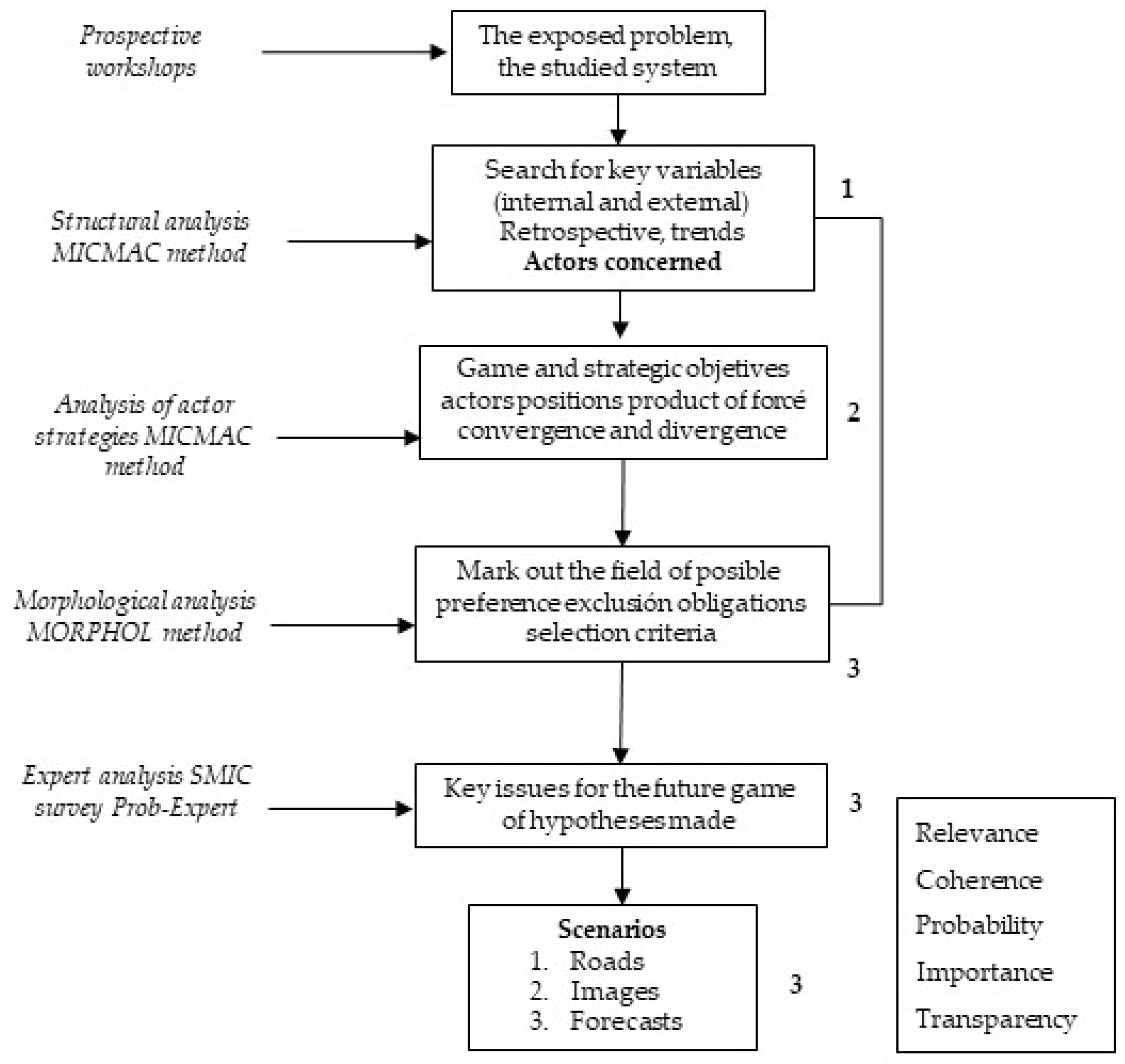
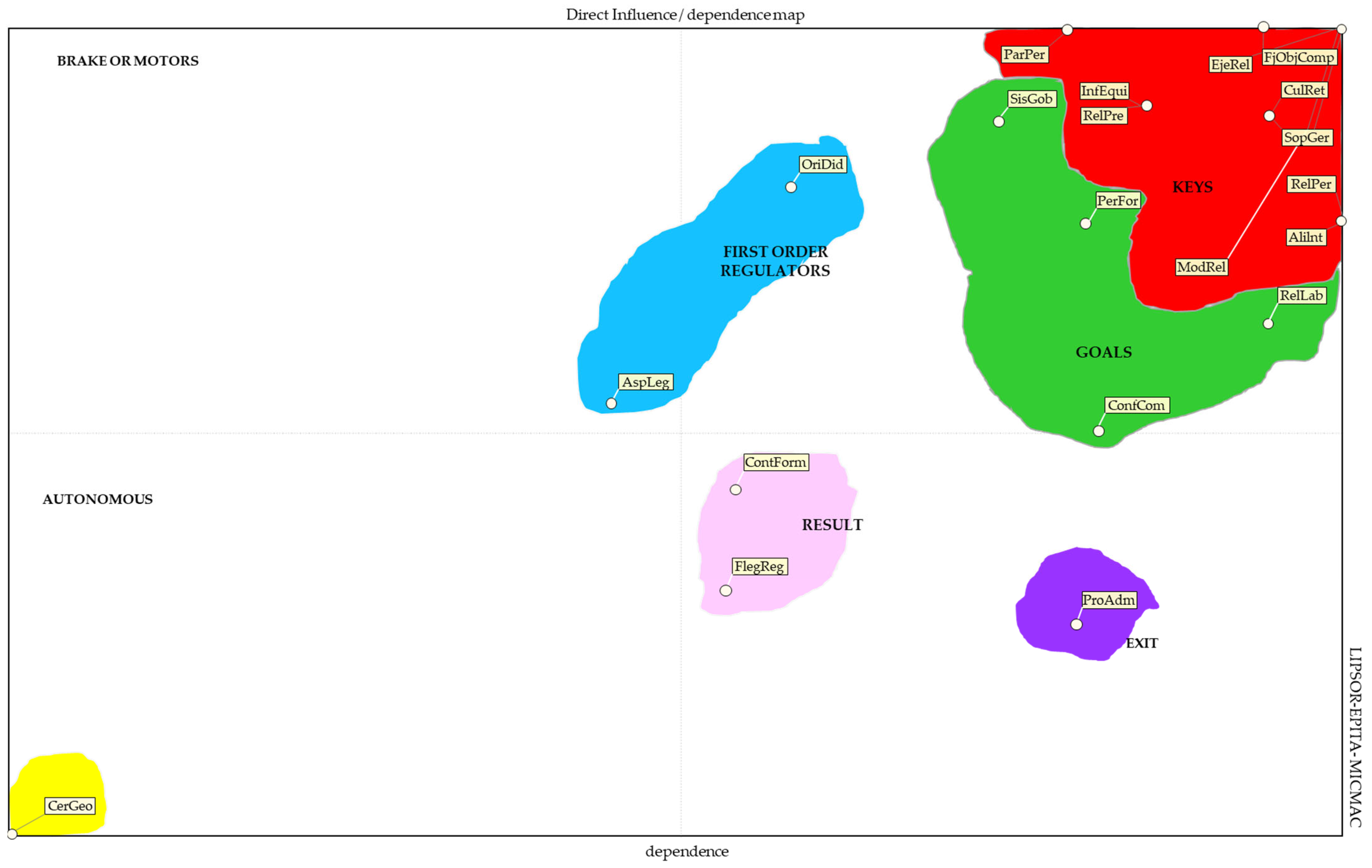
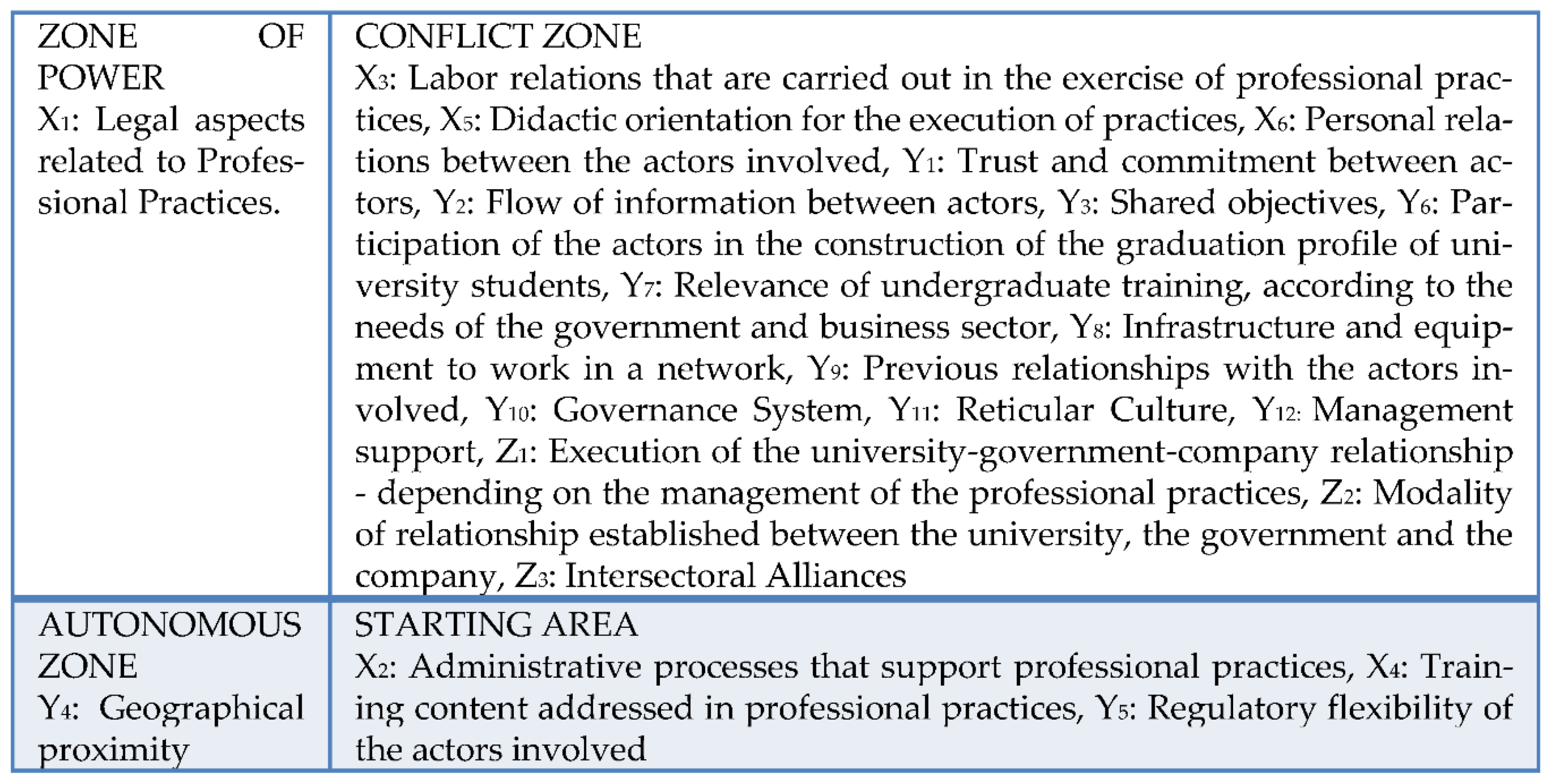
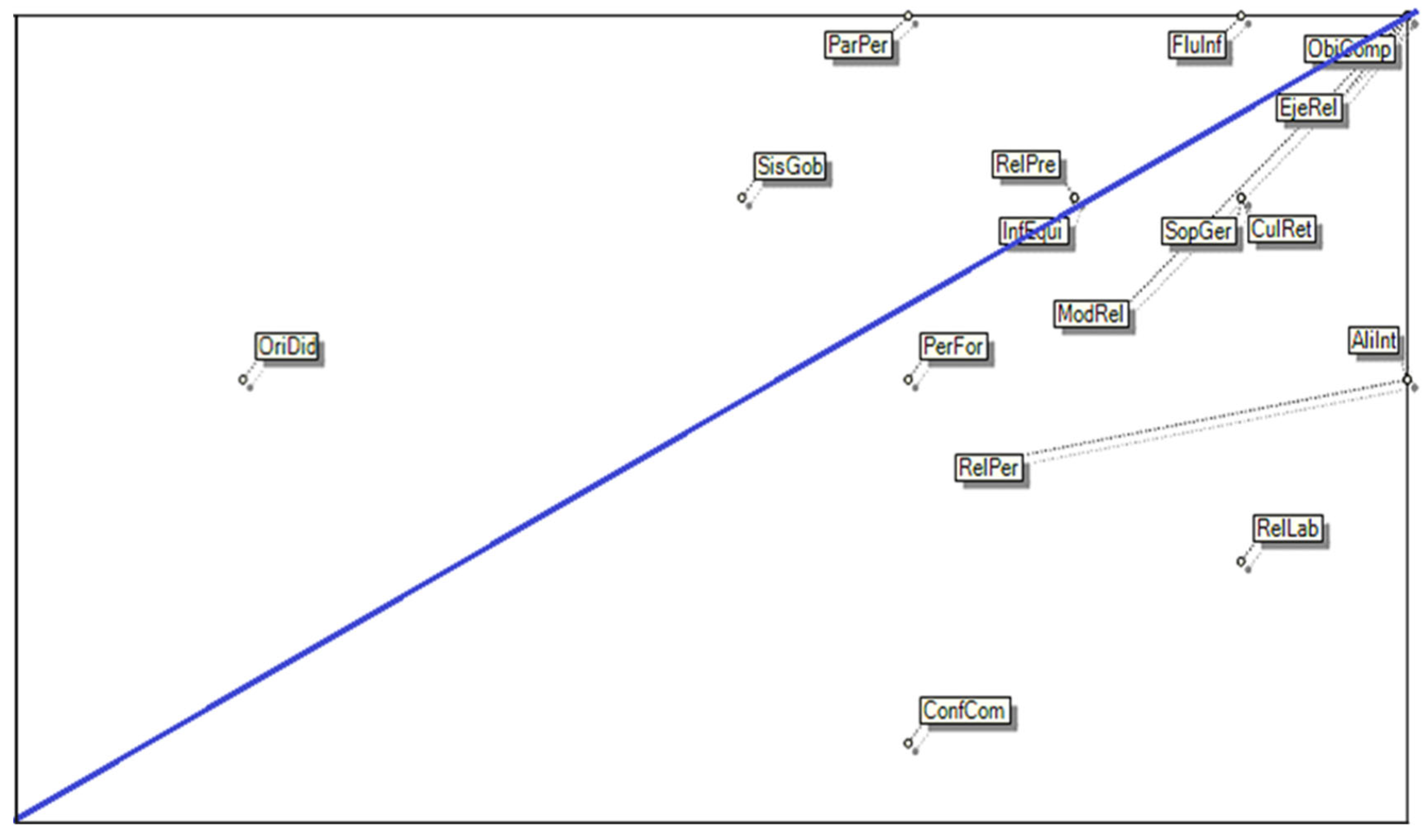

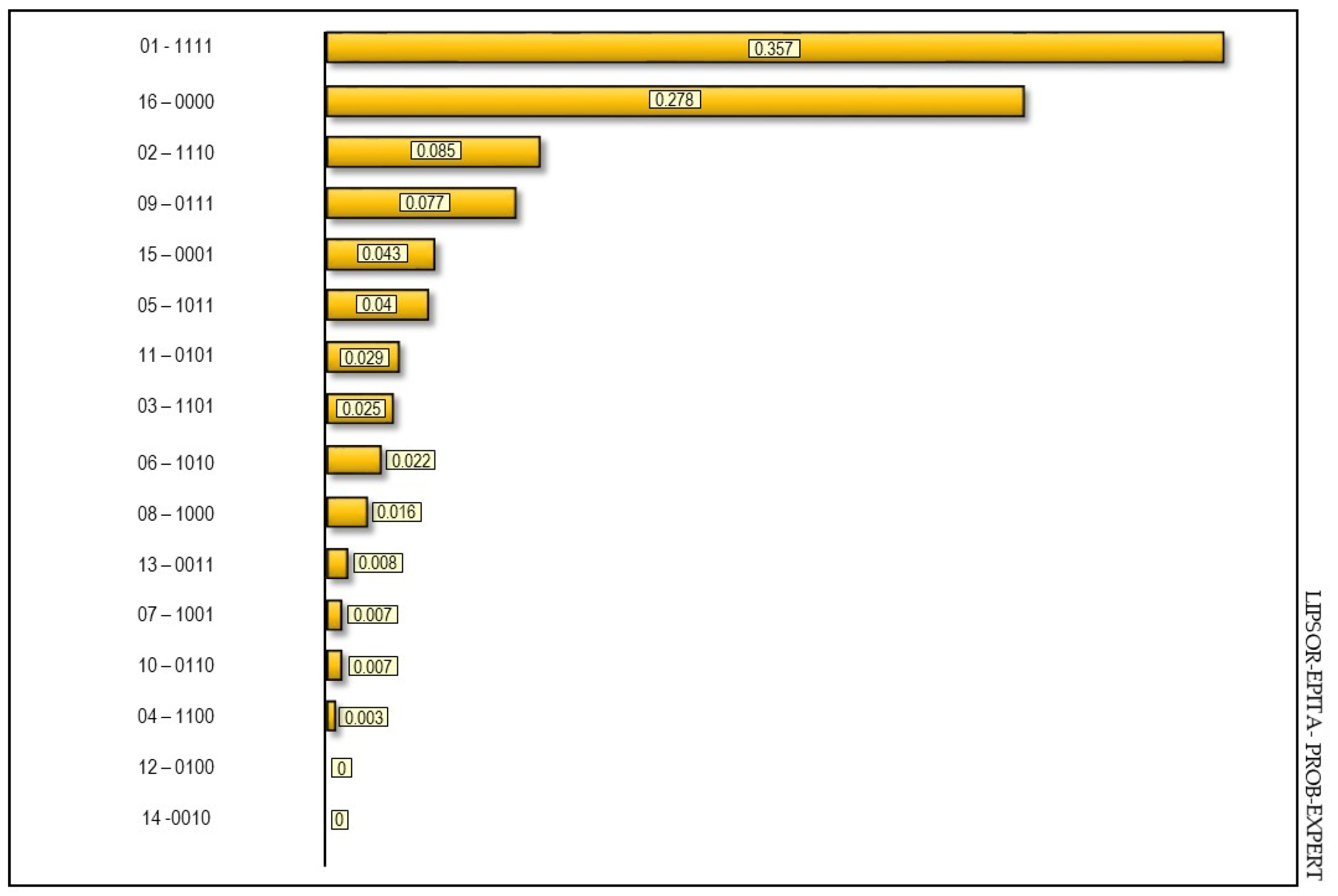
| Dimension | Variable |
|---|---|
| Professional internship programs in the university sector | X1: Legal aspects related to professional practices |
| X2: Administrative processes that support professional practices | |
| X3: Labor relations that are carried out in the exercise of professional practices | |
| X4: Formative contents covered in professional practices | |
| X5: Didactic orientation for the execution of practices | |
| X6: Personal relationships between the actors involved | |
| Intersectoral cooperative relations. | Y1: Trust and commitment between actors |
| Y2: Information flow between actors | |
| Y3: Shared goals | |
| Y4: Geographical proximity | |
| Y5: Regulatory flexibility of the actors involved | |
| Y6: Participation of the actors in the construction of the graduation profile of university students | |
| Y7: Relevance of undergraduate training, according to the needs of the government and business sector | |
| Y8: Infrastructure and equipment for networking | |
| Y9: Previous relationships with the actors involved | |
| Y10: Governance system | |
| Y11: Reticular culture | |
| Y12: Management support | |
| Intersectoral scope university–government sector– business sector | Z1: Execution of the university–government–company relationship based on the management of professional practices |
| Z2: Modality of university–government–company relationship (linkage, association, cooperation) | |
| Z3: Intersectoral alliances |
| Influence of/on | Direct Influence | Motor Skills | ||||||||||||||||||||
|---|---|---|---|---|---|---|---|---|---|---|---|---|---|---|---|---|---|---|---|---|---|---|
| X1 | X2 | X3 | X4 | X5 | X6 | Y1 | Y2 | Y3 | Y4 | Y5 | Y6 | Y7 | Y8 | Y9 | Y10 | Y11 | Y12 | Z1 | Z2 | Z3 | ||
| X1 | 1 | 1 | 0 | 0 | 1 | 0 | 1 | 1 | 0 | 1 | 1 | 1 | 1 | 0 | 1 | 1 | 1 | 1 | 1 | 1 | 15 | |
| X2 | 1 | 1 | 0 | 0 | 1 | 0 | 1 | 1 | 0 | 1 | 1 | 1 | 0 | 1 | 0 | 1 | 0 | 1 | 1 | 1 | 13 | |
| X3 | 0 | 1 | 0 | 0 | 1 | 1 | 1 | 1 | 0 | 1 | 1 | 1 | 1 | 1 | 1 | 1 | 1 | 1 | 1 | 1 | 16 | |
| X4 | 0 | 1 | 0 | 1 | 1 | 1 | 1 | 1 | 0 | 0 | 1 | 1 | 1 | 1 | 0 | 0 | 1 | 1 | 1 | 1 | 14 | |
| X5 | 0 | 1 | 1 | 1 | 1 | 1 | 1 | 1 | 0 | 0 | 1 | 1 | 1 | 1 | 1 | 1 | 1 | 1 | 1 | 1 | 17 | |
| X6 | 0 | 0 | 1 | 1 | 1 | 1 | 1 | 1 | 0 | 1 | 1 | 1 | 1 | 1 | 1 | 1 | 1 | 1 | 1 | 1 | 17 | |
| Y1 | 1 | 1 | 1 | 0 | 1 | 1 | 1 | 1 | 0 | 0 | 0 | 0 | 0 | 1 | 1 | 1 | 1 | 1 | 1 | 1 | 15 | |
| Y2 | 1 | 1 | 1 | 1 | 1 | 1 | 1 | 1 | 0 | 1 | 1 | 1 | 1 | 1 | 1 | 1 | 1 | 1 | 1 | 1 | 19 | |
| Y3 | 1 | 1 | 1 | 1 | 1 | 1 | 1 | 1 | 0 | 1 | 1 | 1 | 1 | 1 | 1 | 1 | 1 | 1 | 1 | 1 | 19 | |
| Y4 | 0 | 0 | 1 | 0 | 0 | 1 | 0 | 0 | 1 | 0 | 0 | 0 | 1 | 1 | 0 | 1 | 1 | 1 | 1 | 1 | 10 | |
| Y5 | 1 | 1 | 1 | 0 | 0 | 1 | 1 | 1 | 1 | 0 | 0 | 0 | 0 | 0 | 1 | 1 | 1 | 1 | 1 | 1 | 13 | |
| Y6 | 1 | 1 | 1 | 1 | 1 | 1 | 1 | 1 | 1 | 0 | 1 | 1 | 1 | 1 | 1 | 1 | 1 | 1 | 1 | 1 | 19 | |
| Y7 | 1 | 0 | 1 | 1 | 1 | 1 | 1 | 1 | 1 | 0 | 0 | 1 | 1 | 1 | 1 | 1 | 1 | 1 | 1 | 1 | 17 | |
| Y8 | 0 | 1 | 1 | 1 | 1 | 1 | 1 | 1 | 1 | 1 | 0 | 1 | 1 | 1 | 1 | 1 | 1 | 1 | 1 | 1 | 18 | |
| Y9 | 0 | 1 | 1 | 1 | 1 | 1 | 1 | 1 | 1 | 1 | 1 | 1 | 1 | 1 | 0 | 1 | 1 | 1 | 1 | 1 | 18 | |
| Y10 | 1 | 1 | 1 | 1 | 0 | 1 | 1 | 1 | 1 | 0 | 1 | 1 | 1 | 1 | 1 | 1 | 1 | 1 | 1 | 1 | 18 | |
| Y11 | 1 | 1 | 1 | 0 | 1 | 1 | 1 | 1 | 1 | 0 | 1 | 1 | 1 | 1 | 1 | 1 | 1 | 1 | 1 | 1 | 18 | |
| Y12 | 1 | 1 | 1 | 1 | 1 | 1 | 1 | 1 | 1 | 0 | 0 | 1 | 1 | 1 | 1 | 1 | 1 | 1 | 1 | 1 | 18 | |
| Z1 | 1 | 1 | 1 | 1 | 1 | 1 | 1 | 1 | 1 | 0 | 1 | 1 | 1 | 1 | 1 | 1 | 1 | 1 | 1 | 1 | 19 | |
| Z2 | 0 | 1 | 1 | 1 | 1 | 1 | 1 | 1 | 1 | 1 | 1 | 1 | 1 | 1 | 1 | 1 | 1 | 1 | 1 | 1 | 19 | |
| Z3 | 0 | 1 | 1 | 1 | 0 | 1 | 1 | 1 | 1 | 0 | 1 | 1 | 1 | 1 | 1 | 1 | 1 | 1 | 1 | 1 | 17 | |
| Dependencia | 11 | 17 | 19 | 13 | 13 | 20 | 17 | 19 | 20 | 3 | 13 | 17 | 17 | 18 | 16 | 19 | 19 | 20 | 20 | 20 | ||
| Variable Symbology | Dependency | % | Motricity | % |
|---|---|---|---|---|
| X1: Legal aspects related to professional practices | 11 | 3.151 | 15 | 4.297 |
| X2: Administrative processes that support professional practices | 17 | 4.871 | 13 | 3.724 |
| X3: Labor relations that are carried out in the exercise of professional practices | 19 | 5.444 | 16 | 4.584 |
| X4: Formative contents covered in professional practices | 13 | 3.724 | 17 | 4.871 |
| X5: Didactic orientation for the execution of practices | 13 | 3.724 | 17 | 4.871 |
| X6: Personal relationships between the actors involved | 20 | 5.730 | 17 | 4.871 |
| Y1: Trust and commitment between actors | 17 | 4.871 | 15 | 4.297 |
| Y2: Information flow between actors | 19 | 5.444 | 19 | 5.444 |
| Y3: Shared objectives | 20 | 5.730 | 19 | 5.444 |
| Y4: Geographical proximity | 3 | 0.859 | 10 | 2.865 |
| Y5: Regulatory flexibility of the actors involved | 13 | 3.724 | 13 | 3.724 |
| Y6: Participation of the actors in the construction of the graduation profile of university students. | 17 | 4.871 | 19 | 5.444 |
| Y7: Relevance of undergraduate training, according to the needs of the government and business sector. | 17 | 4.871 | 17 | 4.871 |
| Y8: Infrastructure and equipment for networking | 18 | 5.157 | 18 | 5.157 |
| Y9: Previous relationships with the actors involved | 18 | 5.157 | 18 | 5.157 |
| Y10: Governance system | 16 | 4.584 | 18 | 5.157 |
| Y11: Reticular culture | 19 | 5.444 | 18 | 5.157 |
| Y12: Management support | 19 | 5.444 | 18 | 5.157 |
| Z1: Execution of the university–government–company relationship depending on the management of professional practices. | 20 | 5.730 | 19 | 5.444 |
| Z2: Modality of relationship established university–government–company | 20 | 5.730 | 19 | 5.444 |
| Z3: Intersectoral alliances | 20 | 5.730 | 17 | 4.871 |
| TOTAL | 349 | 99.99% | 349 | 100% |
| Scenario | H1 | H2 | H3 | H4 |
|---|---|---|---|---|
| E1 | 1 | 1 | 1 | 1 |
| E2 | 0 | 1 | 1 | 1 |
| E3 | 1 | 0 | 1 | 1 |
| E4 | 1 | 1 | 0 | 1 |
| E5 | 1 | 1 | 1 | 0 |
| E6 | 0 | 0 | 1 | 1 |
| E7 | 0 | 1 | 0 | 1 |
| E8 | 0 | 1 | 1 | 0 |
| E9 | 1 | 0 | 0 | 1 |
| E10 | 1 | 0 | 1 | 0 |
| E11 | 1 | 1 | 0 | 0 |
| E12 | 0 | 0 | 0 | 1 |
| E13 | 0 | 0 | 1 | 0 |
| E14 | 0 | 1 | 0 | 0 |
| E15 | 1 | 0 | 0 | 0 |
| E16 | 0 | 0 | 0 | 0 |
| Zone | Values | Concepts |
|---|---|---|
| Zone of improbability | 0.1 | Very unlikely event |
| 0.3 | Unlikely event | |
| Doubt zone | 0.5 | Both likely and unlikely event |
| Zone of Probability | 0.7 | Likely event |
| 0.9 | Very likely event |
| Event | Probability | ||||
|---|---|---|---|---|---|
| Very Unlikely Event | Unlikely Event | Both Likely and Unlikely Event | Likely Event | Very Likely Event | |
| 0.1 | 0.3 | 0.5 | 0.7 | 0.9 | |
| E1 | X | ||||
| E2 | X | ||||
| E3 | X | ||||
| E4 | X | ||||
| Likelihood That These Events Happen | Assuming That These Are Realized | |||
|---|---|---|---|---|
| Event 1 | Event 2 | Event 3 | Event 4 | |
| E1 | 0.808 | 0.846 | 0.732 | |
| E2 | 0.846 | 0.881 | 0.831 | |
| E3 | 0.905 | 0.899 | 0.820 | |
| E4 | 0.772 | 0.837 | 0.808 | |
| Likely That These Events Happen | Assuming That They Are Not Realized | |||
|---|---|---|---|---|
| Event 1 | Event 2 | Event 3 | Event 4 | |
| E1 | 0.207 | 0.131 | 0.309 | |
| E2 | 0.254 | 0.146 | 0.232 | |
| E3 | 0.208 | 0.172 | 0.278 | |
| E4 | 0.357 | 0.239 | 0.263 | |
| Scenarios | Experts |
|---|---|
| 01–1111 | 0.357 |
| 02–1110 | 0.085 |
| 03–1101 | 0.026 |
| 04–1100 | 0.003 |
| 05–1011 | 0.040 |
| 06–1010 | 0.022 |
| 07–1001 | 0.007 |
| 08–1000 | 0.016 |
| 09–0111 | 0.077 |
| 10–0110 | 0.007 |
| 11–0101 | 0.029 |
| 12–0100 | 0 |
| 13–0011 | 0.008 |
| 14–0010 | 0 |
| 15–0001 | 0.043 |
| 16–0000 | 0.278 |
| Number | Scenario | Likelihood of Occurrence | Cumulative Likelihood |
|---|---|---|---|
| 01 | 1111 | 0.357 | 0.357 |
| 16 | 0000 | 0.278 | 0.635 |
| 02 | 1110 | 0.085 | 0.720 |
| 09 | 0111 | 0.077 | 0.797 |
| 15 | 0001 | 0.043 | 0.840 |
| 05 | 1011 | 0.040 | 0.880 |
| 11 | 0101 | 0.029 | 0.909 |
| 03 | 1101 | 0.026 | 0.935 |
| 06 | 1010 | 0.022 | 0.957 |
| 08 | 1000 | 0.016 | 0.973 |
| 13 | 0011 | 0.008 | 0.981 |
| 07 | 1001 | 0.007 | 0.988 |
| 10 | 0110 | 0.007 | 0.995 |
| 04 | 1100 | 0.003 | 0.998 |
| 12 | 0100 | 0 | 0.998 |
| 14 | 0010 | 0 | 0.998 |
Disclaimer/Publisher’s Note: The statements, opinions and data contained in all publications are solely those of the individual author(s) and contributor(s) and not of MDPI and/or the editor(s). MDPI and/or the editor(s) disclaim responsibility for any injury to people or property resulting from any ideas, methods, instructions or products referred to in the content. |
© 2023 by the authors. Licensee MDPI, Basel, Switzerland. This article is an open access article distributed under the terms and conditions of the Creative Commons Attribution (CC BY) license (https://creativecommons.org/licenses/by/4.0/).
Share and Cite
Marín-González, F.; Pérez-González, J.; Senior-Naveda, A.; Narváez-Castro, M.; Moganadas, S.R.; Garcés-Rosendo, E. Betting Scenario for the Management of University Professional Practices from the Conformation of Intersectoral Cooperation Networks. Sustainability 2023, 15, 6215. https://doi.org/10.3390/su15076215
Marín-González F, Pérez-González J, Senior-Naveda A, Narváez-Castro M, Moganadas SR, Garcés-Rosendo E. Betting Scenario for the Management of University Professional Practices from the Conformation of Intersectoral Cooperation Networks. Sustainability. 2023; 15(7):6215. https://doi.org/10.3390/su15076215
Chicago/Turabian StyleMarín-González, Freddy, Judith Pérez-González, Alexa Senior-Naveda, Mercy Narváez-Castro, Sharmila Rani Moganadas, and Eduardo Garcés-Rosendo. 2023. "Betting Scenario for the Management of University Professional Practices from the Conformation of Intersectoral Cooperation Networks" Sustainability 15, no. 7: 6215. https://doi.org/10.3390/su15076215
APA StyleMarín-González, F., Pérez-González, J., Senior-Naveda, A., Narváez-Castro, M., Moganadas, S. R., & Garcés-Rosendo, E. (2023). Betting Scenario for the Management of University Professional Practices from the Conformation of Intersectoral Cooperation Networks. Sustainability, 15(7), 6215. https://doi.org/10.3390/su15076215











